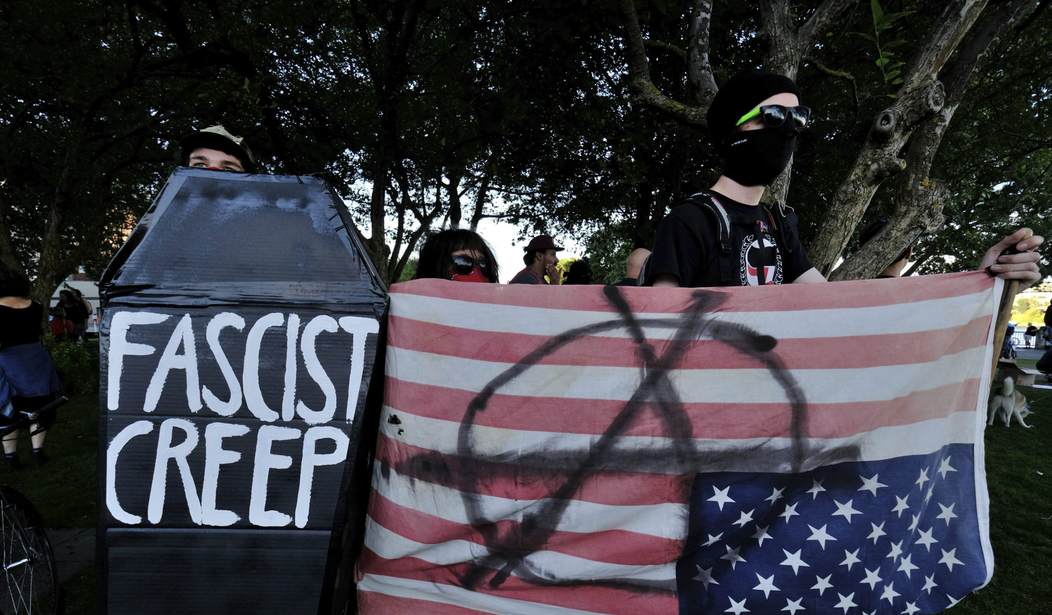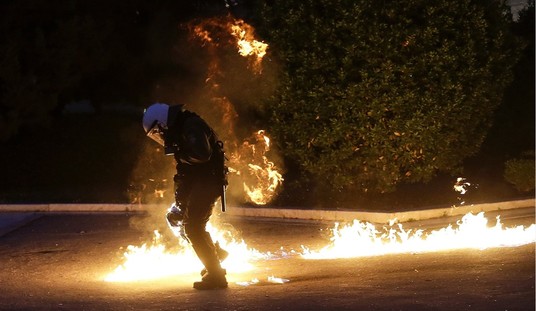Two TV programs, covering both the white nationalists/neo-Nazis and their “Unite the Right” rally and the violent left-wing group Antifa, aired last week. The shows focused on what both groups stand for, and how both groups operate. The coverage serves as a good test as to whether the media can objectively cover these extreme groups, and not openly side with the leftist Antifa by portraying it only as “against hate.”
The first program, by Vice TV, covered Charlottesville and first aired on HBO on Aug. 14. It is now available to watch on other outlets. The young Vice correspondent, Elle Reeve, pulled off what large established networks try to do, but not as effectively.
Reeve and her crew managed to score personal interviews with some of the most repellent white racists, whom you hope never to meet personally. She conducted a long interview with Matthew Heimbach, whom evidently the white nationalists view as their leader, as well as shorter ones with David Duke, Christopher Cantwell, and Robert Ray. Showing their meetings and organizing process, they took the viewer into the world the white nationalists and neo-Nazis live in.
In these interviews, it becomes quite clear that their stated goal — to protest the removal of the statue of Robert E. Lee — was not what motivated hundreds of their members and sympathizers to come from all over the country.
Their real goal was to demonstrate their intention to create a separate all-white ethnostate — although none of the leaders would or could explain how they intend to do so without killing or somehow expelling non-white Americans. When asked, one of their members tried to blow off the question by saying it was just a goal for the future.
On that Friday night, they marched with tiki-torches in a clear imitation of Hitler’s torch-light parades of Nazi marches in Hitler’s Germany. Chanting “Jews will not replace us” and “blood and soil,” the marchers held both Confederate and Nazi flags boldly emblazoned with large swastikas. There was no doubt about what they stood for — they were overt racists and anti-Semites. One marcher said: “This town is run by Jewish communists and niggers.” And Heimbach told Reeve: “The radical left, the state, and the corporations are all on the same Jewish side.”
The most chilling part is the Cantwell interview. He proudly displays the weapons he brought with him, and openly says “none of our people killed anyone unjustly.”
He was implying that the death of Heather Heyer did not pose a problem for him; in fact he says it was “was more than justified.” In the future, Cantwell says with a smile on his face, “a lot more people are going to die here.” To prevent such deaths, according to him, whites need their own “ethno-state.”
The Vice interviews with Leftist activists often allowed them to appear as peaceful “anti-racists.” Most of the interviewees were not apparently Antifa participants or members. They spoke softly and eloquently — and the contrast with the white nationalists and neo-Nazis made the video’s Left-leaning point of view most apparent.
Vice concentrated on only well-spoken, peaceful opponents. Although they did air clips of Antifa attacking racist marchers with sticks, they did not interview many of them.
One would easily conclude after watching the report that the violence largely came from one side — the neo-Nazis and those marching with them.
Vice, however, did publicize the report as one that would take viewers into the heart of the white nationalist world, and in that they succeeded admirably. The second program was more ambitious.
“Fractured America: Extremism on the Streets” filled the entire Aug. 18 episode of 20/20. Its intent was to take viewers into the world of both white nationalists and left-wing violent extremists, concentrating on Antifa. The name is taken from Communist street-fighters in Weimar Germany during the late 1920s and early ’30s who formed “anti-fascist” fighting units.
Like the Vice documentary, ABC interviewed Matt Heimbach, whom they refer to as a “rising star” of the white nationalist movement. Indeed, we see members chanting “Seig Heil” to Heimbach as he passes in front of them, for which he nods some grateful thanks.
His counterpart on the Left is Lacy McCauley. She seems to go from Antifa demonstration to Antifa demonstration around the country, holding signs, rallying her troops with a bullhorn, and acting as a spokesperson. She is a self-described “anarchist,” but the interviewers do not ask her to define what that means to her — nor do they ask if it includes subscribing to a violent strain of anarchist ideology.
However, 20/20 does show, clearly and on camera, that Antifa believes the only way to oppose their enemies is — as one guest notes — through “physical confrontation” and the use of violence.
They are shown running to punch racist opponents, hitting them with large wooden sticks, and even stopping a car and then burning it. For a moment 20/20 shows them last year in Berkeley, California, when Antifa caused over $150,000 in damages to UC Berkeley. The riots were intended to stop scheduled speeches by provocateur Milo Yiannopoulos, and later, columnist Ann Coulter.
The show also aired footage of Antifa members in Washington, D.C., during Trump’s inauguration, smashing the windows of a Starbucks and a Bank of America. McCauley explains that breaking windows is a harmless “symbolic act.” Windows,” she says, “break all the time.” She then agreed that if the reporter wanted to protest her interview with him, it would be OK for him to break the windows in her own home. One wishes he might have proceeded to do that.
They also showed white nationalist leader Richard Spencer speaking to a reporter on the street in Washington, D.C., when an Antifa member — dressed all in black with a scarf hiding his face — walks over to him and punches him hard in the face. McCauley, of course, sees that as fair, since it proves that “Nazis are not invincible.” She seemingly has no concern for the First Amendment and the right of a citizen to voice his or her views, no matter how repellent they may be. She might as well have stated the chant one often hears at their demonstrations: “No free speech for fascists.”
Also interviewed throughout is Daryle Lamont Jackson, a truck driver by day and an Antifa activist. His role is described as “intelligence,” which means he attends all actions and takes photos of the opposition which are catalogued in case of such need in the future. “Doxxing” them, as it is called, is somehow a public duty, even though those identified — and often mistakenly identified — as racists have lost their jobs as a result. One might detest the Nazis, as I do, but we should understand that exercising one’s legal right to protest (the extremists did hold a legitimate permit) should not be the cause of an individual losing a job when, before being identified, the person had no problems at work.
Neo-Nazi and alt-right leader Richard Spencer is also interviewed. Unlike Heimbach and his crew, Spencer comes off as a well-dressed, moderate-speaking, average guy, who simply has a different point of view than anyone else. However, he is also shown at the D.C. meeting months earlier, where he appeared to have the crowd put up its hands in a Nazi salute and chant “heil Trump.”
In the end, the white nationalists and Antifa come off as the mirror image of each other on 20/20.
At a rally scheduled for Pikeville, Kentucky, no one shows but the members of each group. The neo-Nazis hold their event and present their speakers, whose words are heard only by the gathered Antifa members. The downtown is vacant, the stores have been closed, and total silence exists as if the downtown was deserted. The police told shopkeepers to stay home, and put up barriers separating the neo-Nazis from Antifa.
Evidently, this was a staged non-event taking place just for 20/20.
To watch it was a surreal experience. The neo-Nazis proclaimed victory because they could assemble and speak; Antifa are satisfied that they too got TV exposure and publicity. Yet not one citizen living in Pikeville was there, except for the police, who did their job well.
Charlottesville, as we know, was different. Police did not separate both sides, and hence, as ABC’s narrator says: “Both sides, armed with weapons, collide” with each other, having come ready to fight. There is no attempt to whitewash Antifa’s tactics; nor do they make the attempt to brand all the non-violent protestors as Antifa members. There were most likely opponents of “racism” who did not come with Antifa and who did not engage with them in fighting.
ABC proves that the Antifa members did carry sticks with sharp edges, and as the narrator notes, used pepper spray and bottles filled with urine to spray on Heimbach and Spencer’s troops. They even show one protestor — not necessarily a member of Antifa — using a homemade flame-thrower which he aims at a neo-Nazi.
In terms of tactics, ABC says that both sides used similar tactics — although clearly Antifa was there only because the neo-Nazis had scheduled their rally. As for the death of Heather Heyer, Heimbach tells ABC that it was an act of self-defense — that the killer “had a right to defend himself against people trying to kill him.”
At the end of the show, the producers tried to arrange a get-together of the two principals: Spencer from the white nationalists and McCauley of Antifa. Sitting in a park across a picnic table, Spencer approaches her warmly with his outstretched hand, ready to engage in dialogue. Not realizing how she comes off, McCauley refuses — replying that she does not shake hands with Nazis and only wants to defeat them.
Round One for Spencer, his phony moderate style and dress works to hide his noxious racist views.
He claims that he would dissociate himself from anyone who engages in violence, and he accuses the other side of not being willing to do the same. He says that “speech is not violence,” but McCauley says the racist speech which he engages in is no different than violence.
Spencer cleverly tells McCauley: “people like me give meaning to your life.” He is right — but does not comprehend that she does the same for him. Both sides need the other as their enemy; both feed off each other to gain recruits and attain notoriety.
TV coverage helps them do that. It works; both TV specials are the proof.









Join the conversation as a VIP Member